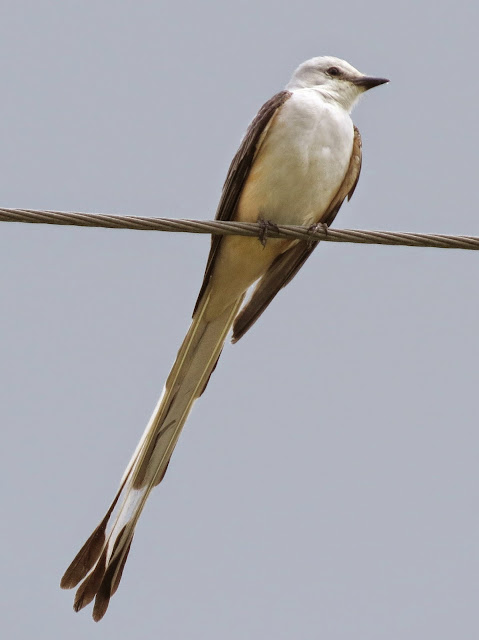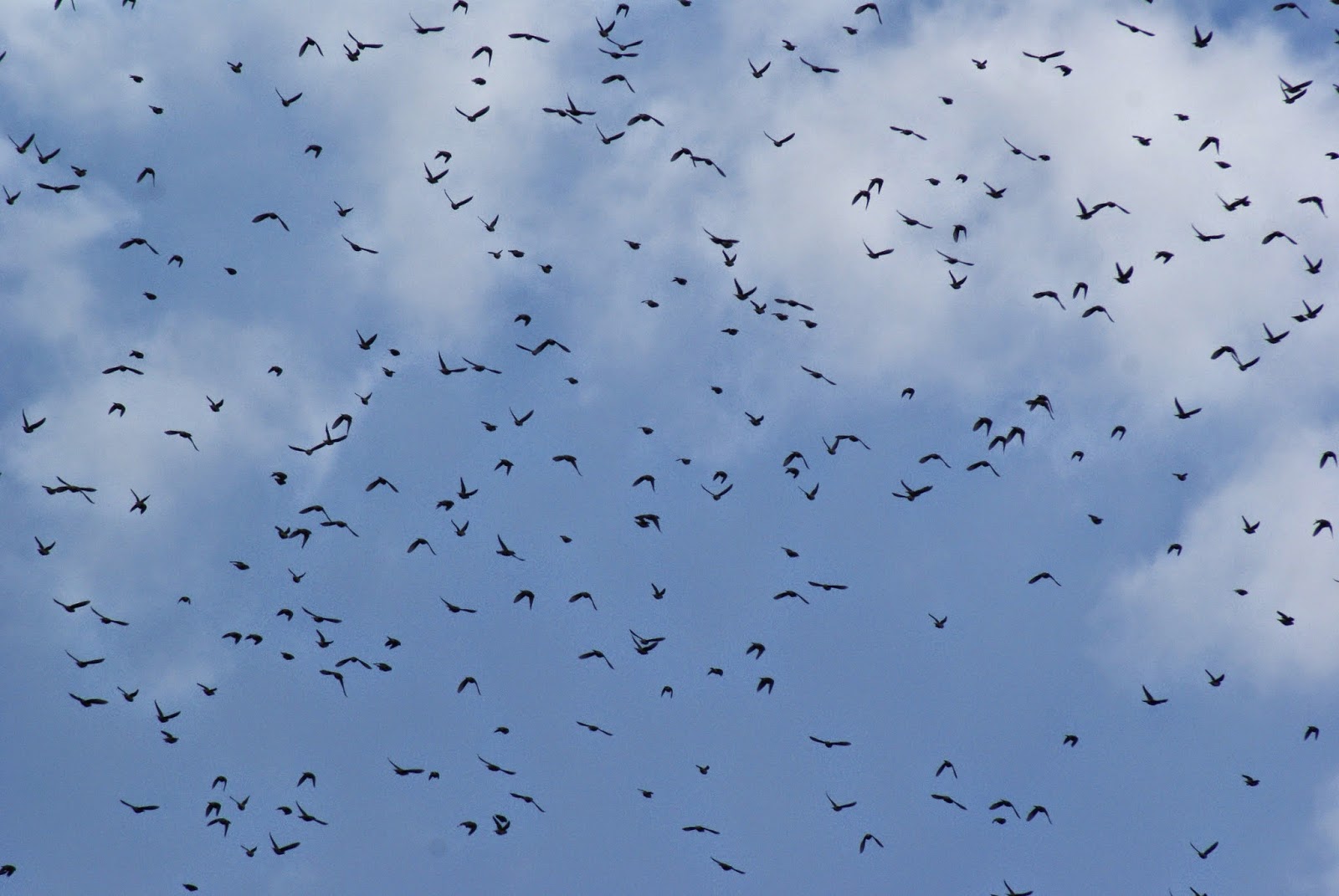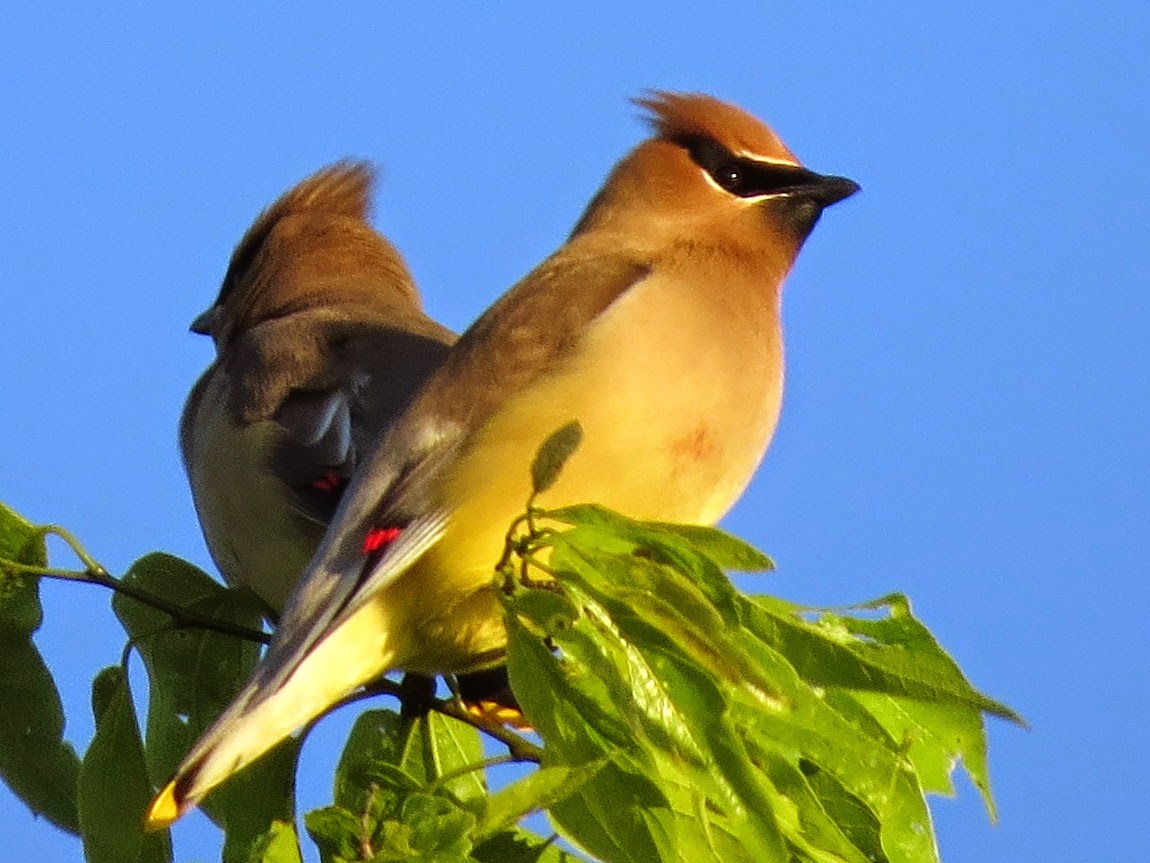.
Dee and I have flown away to Utah. I'm expecting to be able to post about some interesting birds early next week.
While we're away, our resident male Northern Cardinal will no doubt be looking after our backyard.
.
Jeff Mohamed blogs about birds and other wildlife in the Houston area - and occasionally farther afield.
Sunday, May 24, 2015
Wednesday, May 20, 2015
Katy Prairie
.
I still haven't had any time for significant birding outings, I'm afraid. However, at lunchtime today I managed to spend 20 minutes on Longenbaugh Road.
There was a sprinkling of common birds: Mourning and White-winged Doves, European Starlings, Brown-headed Cowbirds and Eastern Meadowlarks. There were also lots of Northern Mockingbirds. Surprisingly, I spotted only a couple of Loggerhead Shrikes.
As always at this time of year, Scissor-tailed Flycatchers were well represented. I stopped counting at 14.
I'm used to Scissortails now but I remember how bowled over I was when I saw my very first one, on a brief business trip to Houston almost fifteen years ago.
Longenbaugh can usually be relied upon to produce a Crested Caracara or two. Today two were perched on a utility pole. I can never decide whether their crests and stout beaks make them lok imposing or just rather silly.
As soon as I had photographed the Caracaras, it started to rain and so I headed back to work. This weekend we'll be heading out of town for a vacation and so it'll be a while before I get a chance to check out the Katy Prairie again.
.
I still haven't had any time for significant birding outings, I'm afraid. However, at lunchtime today I managed to spend 20 minutes on Longenbaugh Road.
There was a sprinkling of common birds: Mourning and White-winged Doves, European Starlings, Brown-headed Cowbirds and Eastern Meadowlarks. There were also lots of Northern Mockingbirds. Surprisingly, I spotted only a couple of Loggerhead Shrikes.
As always at this time of year, Scissor-tailed Flycatchers were well represented. I stopped counting at 14.
I'm used to Scissortails now but I remember how bowled over I was when I saw my very first one, on a brief business trip to Houston almost fifteen years ago.
Longenbaugh can usually be relied upon to produce a Crested Caracara or two. Today two were perched on a utility pole. I can never decide whether their crests and stout beaks make them lok imposing or just rather silly.
As soon as I had photographed the Caracaras, it started to rain and so I headed back to work. This weekend we'll be heading out of town for a vacation and so it'll be a while before I get a chance to check out the Katy Prairie again.
.
Friday, May 15, 2015
Bits and Pieces
.
Bad weather and too much work have combined to prevent me making any birding trips for the past couple of weeks. So I have had to make do with occasional opportunities to watch our backyard birds and a few quick walks around the college nature trail.
You can tell that spring is here by the number of young birds in our backyard. Our resident Carolina Chickadees have been bringing their young to our feeders. One of the parents seemed to be so tired with feeding its offspring that it lay down for a quick rest on our fence.
It was soon up and back at work again, though.
Our resident pair of Carolina Wrens are raising three young this year. At first the adults would park the young in a hanging basket and then bring food to them from our feeders.
The young birds are now getting bolder and spend a lot of time on our fence.
It is too early for baby Northern Cardinals yet. However, the male has been feeding his mate and so it won't be long before nesting occurs.
A female Ruby-throated Hummingbird has been enjoying some of our flowering plants, as well as a hummer feeder.
There has been a lot of non-bird activity in our yards, too. Anoles seem to pop up everywhere, including on our prickly pear.
Monarch butterflies are visiting regularly. Our milkweed plants are just recovering from the winter but they have had enough leaves to keep one Monarch caterpillar going.
The college campus has been fairly quiet for birds, although we still have a flock of 1000+ Cedar Waxwings and scores of Cliff Swallows are nesting under one of our bridges.
A few migrants have trickled through but have only appeared when the light was too low for photos. More exciting has been the appearance of a Carolina Wren this week. They used to be common residents on the campus but this is the first one I've seen in over five years. I hope it decides to settle here!
.
Bad weather and too much work have combined to prevent me making any birding trips for the past couple of weeks. So I have had to make do with occasional opportunities to watch our backyard birds and a few quick walks around the college nature trail.
You can tell that spring is here by the number of young birds in our backyard. Our resident Carolina Chickadees have been bringing their young to our feeders. One of the parents seemed to be so tired with feeding its offspring that it lay down for a quick rest on our fence.
It was soon up and back at work again, though.
Our resident pair of Carolina Wrens are raising three young this year. At first the adults would park the young in a hanging basket and then bring food to them from our feeders.
The young birds are now getting bolder and spend a lot of time on our fence.
It is too early for baby Northern Cardinals yet. However, the male has been feeding his mate and so it won't be long before nesting occurs.
A female Ruby-throated Hummingbird has been enjoying some of our flowering plants, as well as a hummer feeder.
There has been a lot of non-bird activity in our yards, too. Anoles seem to pop up everywhere, including on our prickly pear.
Monarch butterflies are visiting regularly. Our milkweed plants are just recovering from the winter but they have had enough leaves to keep one Monarch caterpillar going.
The college campus has been fairly quiet for birds, although we still have a flock of 1000+ Cedar Waxwings and scores of Cliff Swallows are nesting under one of our bridges.
A few migrants have trickled through but have only appeared when the light was too low for photos. More exciting has been the appearance of a Carolina Wren this week. They used to be common residents on the campus but this is the first one I've seen in over five years. I hope it decides to settle here!
.
Friday, May 08, 2015
Baytown Nature Center
.
If Spoonbills and Ibis were the most obvious birds at Baytown on Sunday, they certainly weren't the only ones there, although they were among the easiest to photograph.
My first-of-year Black-crowned Night Heron absolutely refused to come out of the shadows or to let me approach it.
Only one of several Yellow-crowned Night Herons was more obliging.
I did just a little better with the first Tricolored Heron that I spotted.
However, a second one let me watch it fishing.
Great and Snowy Egrets were everywhere. Some Snowy Egrets were competing with each other for food.
Others had found their own patches.
Although ducks were generally scarce, there were a few Blue-winged Teal.
There were several Black-bellied Whistling Ducks, too.
Shorebirds were much less abundant than I had hoped, with the most common being Least Sandpipers.
I was surprised to see only a single Black-necked Stilt, a bird I always enjoy watching.
I was pleased to see my first White-rumped Sandpiper of 2015.
My final birds were also first-of-year ones: Baird's Sandpipers.
So, as usual, Baytown had produced a nice variety of birds and some good photo opportunities.
.
If Spoonbills and Ibis were the most obvious birds at Baytown on Sunday, they certainly weren't the only ones there, although they were among the easiest to photograph.
My first-of-year Black-crowned Night Heron absolutely refused to come out of the shadows or to let me approach it.
Only one of several Yellow-crowned Night Herons was more obliging.
I did just a little better with the first Tricolored Heron that I spotted.
However, a second one let me watch it fishing.
Great and Snowy Egrets were everywhere. Some Snowy Egrets were competing with each other for food.
Others had found their own patches.
Although ducks were generally scarce, there were a few Blue-winged Teal.
There were several Black-bellied Whistling Ducks, too.
Shorebirds were much less abundant than I had hoped, with the most common being Least Sandpipers.
I was surprised to see only a single Black-necked Stilt, a bird I always enjoy watching.
I was pleased to see my first White-rumped Sandpiper of 2015.
My final birds were also first-of-year ones: Baird's Sandpipers.
So, as usual, Baytown had produced a nice variety of birds and some good photo opportunities.
.
Monday, May 04, 2015
Baytown: Spoonbills and Ibis
.
After the frustrations of trying to spot and photograph migrants over the past couple of weeks, I decided to head to Baytown Nature Center on Sunday morning. There are usually plenty of birds at the site and many of them are close enough to the road to be easily photographed.
As soon as I reached the first pond, I knew it was going to be a good day for wading birds. A score or more White Ibis were fishing alongside a Roseate Spoonbill and Snowy Egrets, while Black-bellied Whistling Ducks were lurking in the background.
The next wetland area had a dozen Roseate Spoonbills.
Spoonbills fish by dipping part of their bill in the water and sweeping it from side to side.
One of the Spoonbills was more concerned with preening than finding breakfast.
I would expect that Spoonbills would object to sharing their fishing area with White Ibis. However, the two species seemed content to fish the same patch of water.
Perhaps one reason they are not territorial in these situations is that they have different prey species in their sights. Or it may be that they fish at different depths, since White Ibis plunge their whole bills into the water while the Spoonbills seem to search closer to the water's surface.
While I walked the main loop trail later during my visit, White Ibis seem to pass overhead every couple of minutes. I must have seen at least 60 or 70 on my walk.
While the Spoonbills and Ibis were a joy to watch, I was also hoping that Baytown would produce a good range of other species. As you'll see in my next post, I wasn't disappointed.
.
After the frustrations of trying to spot and photograph migrants over the past couple of weeks, I decided to head to Baytown Nature Center on Sunday morning. There are usually plenty of birds at the site and many of them are close enough to the road to be easily photographed.
As soon as I reached the first pond, I knew it was going to be a good day for wading birds. A score or more White Ibis were fishing alongside a Roseate Spoonbill and Snowy Egrets, while Black-bellied Whistling Ducks were lurking in the background.
The next wetland area had a dozen Roseate Spoonbills.
Spoonbills fish by dipping part of their bill in the water and sweeping it from side to side.
One of the Spoonbills was more concerned with preening than finding breakfast.
I would expect that Spoonbills would object to sharing their fishing area with White Ibis. However, the two species seemed content to fish the same patch of water.
Perhaps one reason they are not territorial in these situations is that they have different prey species in their sights. Or it may be that they fish at different depths, since White Ibis plunge their whole bills into the water while the Spoonbills seem to search closer to the water's surface.
While I walked the main loop trail later during my visit, White Ibis seem to pass overhead every couple of minutes. I must have seen at least 60 or 70 on my walk.
While the Spoonbills and Ibis were a joy to watch, I was also hoping that Baytown would produce a good range of other species. As you'll see in my next post, I wasn't disappointed.
.
Friday, May 01, 2015
The Working Week
.
Although this week saw better weather on the CyFair campus, there was still a sprinkling of migrants around every day. Seven species of warblers turned up: Ovenbird, Yellow-breasted Chat, American Redstart, Black-and-white, Bay-breasted, Blackburnian and Black-throated Green (below).
Other migrants were Eastern Wood-Pewee, Great Crested Flycatcher, Gray Catbird, Chuck-will's-widow, Baltimore Oriole and Rose-breasted Grosbeak.
With so many migrants passing through, it's easy to forget to admire local residents like Northern Cardinals.
On some of my walks around the nature trail, I found it hard to pick out the movement of migrants because one or other of our winter/spring flocks of hundreds of Cedar Waxwings kept wandering through the trees or swirling overhead.
However, it's hard to resent the Waxwings' presence, given that they are such beautiful birds!
Of course, looking so good takes a certain amount of effort.
Several Western Kingbirds have turned up again this April.
Another recent arrival is a Cooper's Hawk.
I've noticed what seems to be a mating pair of Green Herons hanging around the nature trail. This morning one of them had moved across to the staff parking lot, which seems odd habitat for a heron.
Meanwhile the campus Purple Martin nesting gourds appear to be fully occupied.
I never tire of watching the Martins as they soar overhead.
I wish they would fly a little lower and gobble up some of the many mosquitoes that I encounter whenever I walk the nature trail!
P.S.
We've also had a lot of butterflies this week, including Monarchs, Common Buckeyes and Clouded Sulphurs. My favorite, though, was this Pipevine Swallowtail.
.
Although this week saw better weather on the CyFair campus, there was still a sprinkling of migrants around every day. Seven species of warblers turned up: Ovenbird, Yellow-breasted Chat, American Redstart, Black-and-white, Bay-breasted, Blackburnian and Black-throated Green (below).
Other migrants were Eastern Wood-Pewee, Great Crested Flycatcher, Gray Catbird, Chuck-will's-widow, Baltimore Oriole and Rose-breasted Grosbeak.
With so many migrants passing through, it's easy to forget to admire local residents like Northern Cardinals.
On some of my walks around the nature trail, I found it hard to pick out the movement of migrants because one or other of our winter/spring flocks of hundreds of Cedar Waxwings kept wandering through the trees or swirling overhead.
However, it's hard to resent the Waxwings' presence, given that they are such beautiful birds!
Of course, looking so good takes a certain amount of effort.
Several Western Kingbirds have turned up again this April.
Another recent arrival is a Cooper's Hawk.
I've noticed what seems to be a mating pair of Green Herons hanging around the nature trail. This morning one of them had moved across to the staff parking lot, which seems odd habitat for a heron.
Meanwhile the campus Purple Martin nesting gourds appear to be fully occupied.
I never tire of watching the Martins as they soar overhead.
I wish they would fly a little lower and gobble up some of the many mosquitoes that I encounter whenever I walk the nature trail!
P.S.
We've also had a lot of butterflies this week, including Monarchs, Common Buckeyes and Clouded Sulphurs. My favorite, though, was this Pipevine Swallowtail.
.
Subscribe to:
Posts (Atom)




















































